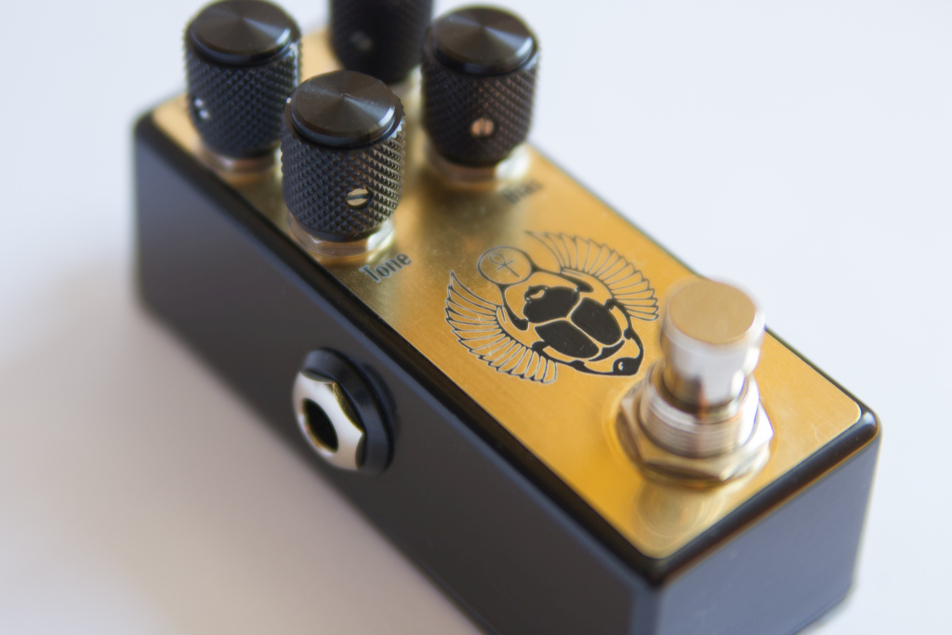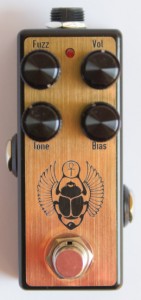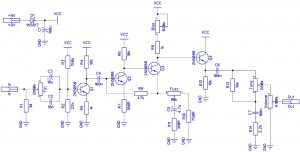
Ankh
The “fuzz” is the third typical distortion device in the arsenal of guitarists next to “overdrives” and “distortions”. In some forums there are long discussions and debates about these categories. I don’t want to play this game especially because I don’t think that there is a real objective way to  distinguish them. For me a fuzz is what sounds like a fuzz. This is an absolutely subjective definition, but I don’t know any better. Still what do I mean by that? Well, this is a bit like talking about wines… But I write here a few attributes that I associate with fuzzes: “thick”, “saturated”, “compressed”, “fizzy” and sometimes “gated”. Of course these attributes can be used in conjunction with other distortion types as well, so I didn’t say too much. Maybe it is better to list here a few songs that have that typical fuzzy sound: Queens Of The Stone Age – Little Sister; Edwin Collins – A Girl Like You; The White Stripes – Seven Nation Army (however here the octacve plays a prominent role too). And of course the fans of classics would also list here some songs from Jimmy Page and Jimi Hendrix.
distinguish them. For me a fuzz is what sounds like a fuzz. This is an absolutely subjective definition, but I don’t know any better. Still what do I mean by that? Well, this is a bit like talking about wines… But I write here a few attributes that I associate with fuzzes: “thick”, “saturated”, “compressed”, “fizzy” and sometimes “gated”. Of course these attributes can be used in conjunction with other distortion types as well, so I didn’t say too much. Maybe it is better to list here a few songs that have that typical fuzzy sound: Queens Of The Stone Age – Little Sister; Edwin Collins – A Girl Like You; The White Stripes – Seven Nation Army (however here the octacve plays a prominent role too). And of course the fans of classics would also list here some songs from Jimmy Page and Jimi Hendrix.
Fuzzes have a very distinctive sound, but exactly because they are heavily compressed they are often hard to put in the musical environment. One needs to learn how to play them, most of them are not really suited for chords, but rather for riffs or solos. Like many of the fellow guitar players I’ve been in search for “The Distortion”. From the three types the hardest for me was to find the best fuzz. I know myself and I know that I’ll try many fuzzes in the future, but right now I think with the Basic Audio Scarab Deluxe I’ve found what I need. Really versatile, ballsy sounding and it does not disappear in the mix. Here is a little video for the sounds (the guitar is tuned to dropC):
 The circuit is similar to a Si Tone Bender, where a buffer has been added to the end. With the Fat pot you can change between the 10nF and 10uF input caps steplessly. This and the externel Bias control make this effect really versatile. Since the part number is quite low it is possible to build the effect into a 1590A box too, but then the five pots will not fit. In that version I have omitted the Fat control and the 10nF C2 cap and used the 10uF C3 cap only since I’ve found that most of the time I’m using the effect with the Fat pot maxed out anyway.
The circuit is similar to a Si Tone Bender, where a buffer has been added to the end. With the Fat pot you can change between the 10nF and 10uF input caps steplessly. This and the externel Bias control make this effect really versatile. Since the part number is quite low it is possible to build the effect into a 1590A box too, but then the five pots will not fit. In that version I have omitted the Fat control and the 10nF C2 cap and used the 10uF C3 cap only since I’ve found that most of the time I’m using the effect with the Fat pot maxed out anyway.
Both versions can be found in the build docu under the Projects menu.


No Comments